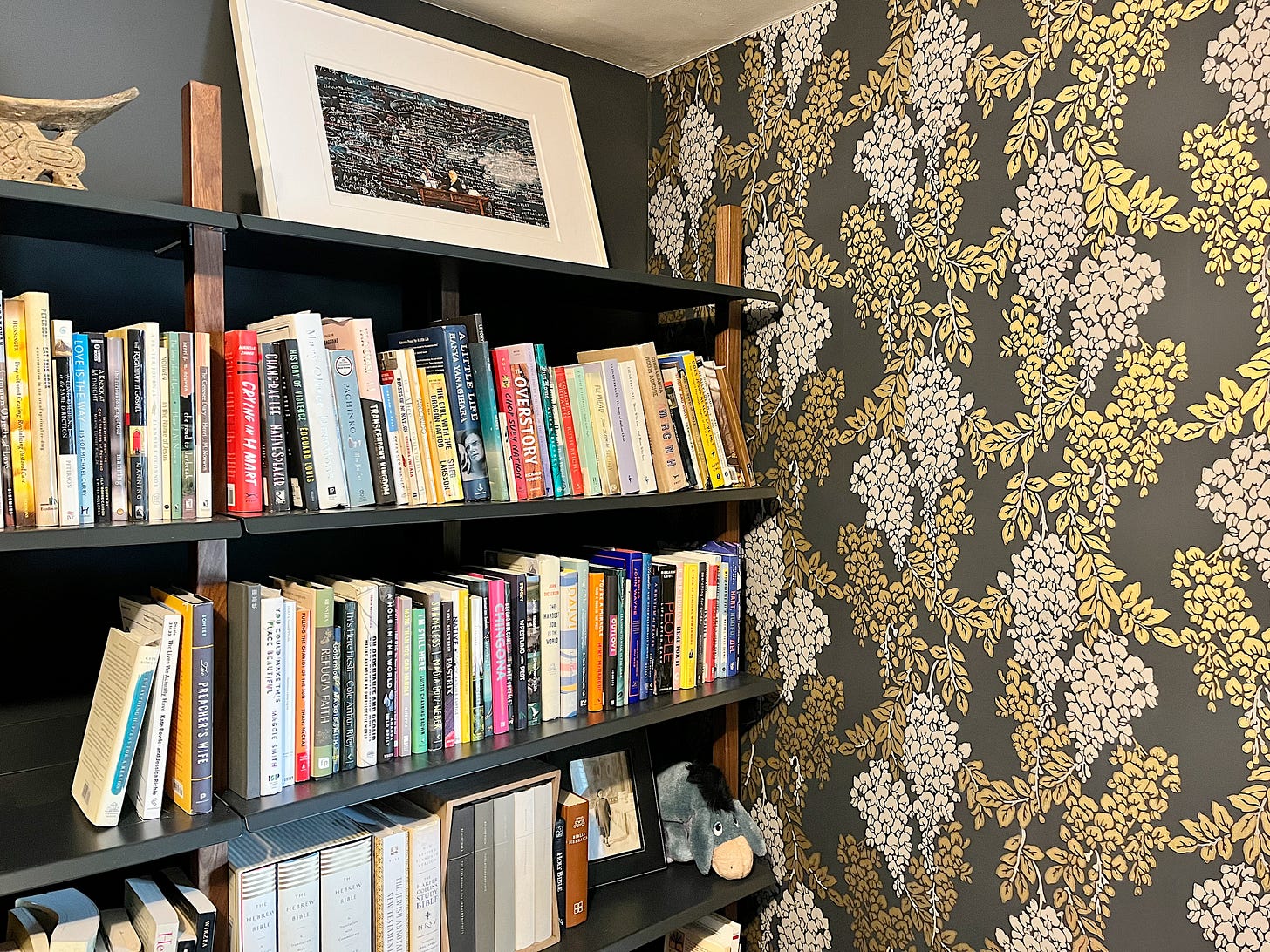To Be Amazed
Some fragmented thoughts on our need for beauty, making wondrous spaces, strawberry-rhubarb pie, hydrangeas, and the role of the preacher
Saturday, June 24
Grand Rapids, Mich.
We’ve been working hard to finish my study, which will eliminate an entire category of excuses as to why I’ve made relatively little progress on my book. And when I say “we,” I mean mainly Tristan, who is now working on refinishing a closet door.
It’s really for the best that he’s done most of the rehab. One of my jobs was to make sure that there was enough room for the bookshelves. I measured and then I measured again, and then I went online and looked at the dimensions: 38 inches wide for the main bookshelf, 37 inches for the add-on. It turns out that 38 + 37 does not = 65, like I had it in my head! According to the complex, upper-level mathematics that I learned a while back, you have to carry the 1, which means that 38 + 37 = 75, which means the bookshelves fit with maybe half an inch to spare.
😬😬😬
The bookshelves, from the Minneapolis-based company BluDot, are sturdy—walnut and steel. On the top shelves I have a wooden Shona headrest I got on a reporting trip in Zimbabwe as well as a print of a photograph by the Chinese artist Wang Qingsong that is a commentary about modern China’s engagement with the West. And finally, I have a home for all my books. (OK, just some of them, because I have a book-buying problem.) On the top, ones I’ve especially loved, including Min Jin Lee’s Pachinko and Yaa Gyasi’s Transcendent Kingdom, The Overstory, by Richard Powers, and A Little Life, by Hanya Yanagihara. The next shelf down has books written by friends and colleagues. Below that, my Bibles, as well as an old photo of my beloved paternal grandmother, who taught me to love Scripture, and my stuffed Eeyore.
The wallpaper is from the English company Farrow & Ball. It’s called Wisteria, and it was inspired by a 19th century pattern woven in silk on a jacquard loom. One of the things I love about Farrow & Ball’s wallpaper is the work that goes into them: The background color on the wallpaper is applied by brush, and then the pattern is printed atop that, so you get all the inevitable irregularities that come from something crafted that way. It is perfectly imperfect.
But what is all this for?
In her book The Silent Cry, the German theologian Dorothee Sölle recounts a story from that time of life when her eldest son was learning his numbers. She found him standing transfixed in front of someone else’s house, staring at the house numbers, and just as she was about to urge him on, he exclaimed, “Look, Mummy, what a wonderful 537!” “He spoke the number slowly, tasting it in a mood of discovery,” she writes. She saw in him “a radical amazement that tears apart the veil of triviality. Nothing is to be taken for granted, least of all beauty.”
She learned from her son’s attention to beauty, “even on a busy street and made visible in a blue-and-white number plate on the wall of a house”: “To be amazed means to behold the world and, like God after the sixth day of creation, to be able to say again or for the first time, ‘Look! How very good it all is!’... The soul needs amazement,” she writes, calling wonder a kind of liberation from all that might “make us untouchable and insensitive... What appears obvious is that we need to be touched by the spirit of life and that without amazement and enthusiasm nothing new can begin.”
Of course house numbers can just be house numbers, and a book can just be a book, and wallpaper can just be wallpaper—there in the background, unnoticed and unseen. Or we can revel in owning things, even to the degree that things begin to own us. But Sölle reminds me that another option is to put what we have into the service of something more by finding and appreciating their beauty.
When I pay attention to these things, I remember the effort, the expertise, the creativity, and the care that went into making them. Each cascade of blossoms on the wallpaper, each paragraph of each book, each wooden upright, each object: They inspire me. They make me want to craft more concise, more elegant sentences. They urge me to be a more thoughtful human. They encourage me constantly to cultivate my sense of wonder—in every sense of that marvelous word.
Of course it doesn’t have to be an entire room or some extensive renovation project. It could just be one meaningful object: a memento, a framed photograph of someone who has loved you well, your favorite flower popped into a mason jar. In Conjectures of a Guilty Bystander, Thomas Merton writes about an icon of Elijah that he put up on the wall of an abbey. Though it was just a copy, he found it “fabulously beautiful, delicate and strong... What a thing to have in the room. It transfigures everything.”

Spaces matter—or at least they should. They shape us in ways that we often don’t even perceive. I get almost angry sometimes, for instance, at the ugliness of many of today’s churches, because they reinforce the artificial, even blasphemous, disconnection of body and soul.
Beauty matters—or at least it can. If I truly believe, as I sometimes say I do, in a loving God whose imagination was expressed in lavish creativity, then beauty, rightly perceived and faithfully appreciated, points us once again back to love.
What I’m Cooking: I am a far more confident cook than I am a baker. But it would be wrong to let this season of strawberry and rhubarb pass without baking a few things. A couple weeks ago, I did my usual crumble; it’s one of my go-to desserts, whatever fruit is at the market. But last week, we had friends coming for dinner and I realized I hadn’t made a pie in quite a while. So strawberry-rhubarb pie it was.
I used this excellent recipe from Florence Fabricant of The New York Times. (If you don’t have a Times subscription, you can also find the recipe here.) I always read the comments to see what has worked for other people and what hasn’t. So, with their guidance, I cut the sugar in half (it was plenty sweet for our palates); flipped the proportion of strawberry to rhubarb, 3 cups to 2 in the original recipe, the other way around; and used cornstarch instead of tapioca, because that’s what I had on hand. Oh, one other tweak: I could not find my rolling pin anywhere, so I ended up using a mason jar. I do not recommend this! Anyway, my lattice work was the usual mess—I am so slow that, by the time I roll it out and cut, the butter is too warm and the dough turns stick—but it tasted great.
What I’m Growing: The blossoms on the hydrangea in front of the house are just beginning to get some color. I’m delighted. They’re one of my favorite flowers.
I’ve read that acidic soils produce classic blue blooms, whereas more alkaline ones mean purple or pink. Here’s our mystery: On one stem, we have blue and the next one over will bloom pink. Master gardeners, what’s going on? I’d love to know.
I realized that there were some questions from my “ask me anything” call a while back that I’d failed to answer, not because I didn’t want to but just because I forgot. So here’s one from Leigh: What is the role of a preacher? What are we called to offer the congregation in giving a homily message? My church, in particular, preaches from the lectionary each week. I'm new to preaching (in my second year of seminary), and am interning at my local church, and I'm now on the regular preaching rotation.
There are entire books written about this—and many, many, many of them do not agree! I bet if you ask 1,000 preachers, you’ll get 1,000 different answers. I do hope the same themes and core principles might emerge, but I’m guessing you’d get some profoundly divergent perspectives.
To me, the role of the preacher is to bring good news, sacred and hopeful and relevant good news. I long for the preacher to tell me just a bit about how the story of God—a story of wild creativity and boundless imagination, a story of embodied grace and divine boundary-crossing, a story of love—transforms the story of humanity.
Of course any speaker can do this. But I think the preacher is called to help the congregation see this through the lens of Scripture. That, to me, is what differentiates a sermon or a homily from a talk. In my tradition, the minister’s formal title is “minister of Word and sacrament.” Though I’m not an ordained minister, I never forget the “Word” part of that when I preach. It should be the basis of all that I say.
When I’m preaching in a congregation that I don’t know well, I try always to ask a pastor or lay leader who does know that congregation: “What do you think your people need to hear?” Note I say “need,” not “want.” A key part of the preacher’s role is listening: listening both to what the Spirit might put on your heart as well as to what the cries of the congregation’s own hearts might be. A sermon might be a fine piece of writing or a beautiful work of oratory, but unless it can touch and move something—and someone—in the midst of that specific congregation, unless it can communicate with those particular people in language that they can apprehend, unless they can feel stirred in some way about God’s love in the world, can it really be considered a good sermon?
Send your healing vibes and heartfelt prayers up for the Fozz. Our old guy has had a rough stretch of late. Last night wasn’t a great night for either of us, seeing as he woke me at 4 a.m., whimpering to go out, and then I stepped in his poop, which was generously dolloped across the living-room floor. His timing could use some improvement. Anyway, Fozzie slept in today. I think he needed the rest.
What’s on your hearts this week? Anything I can be praying for?
As ever, I’m so grateful we can stumble through all this together, and I’ll try to write again soon.
All my best,
Jeff









Transcendent Kingdom is one of my favourite books. I truly love it.
What a timely reminder of the importance of beauty. Your comment that spaces (should) matter really struck me. My home church is what people have often described as a “thin place”. It is 900 years old this year, but is under the axe because, at the time it was built, proper concern was not paid to wheelchair access. Irrespective of the fact that people who rely on wheelchairs have found their way in with the help of family and friends. As I write, the friends lowering the lame man to Jesus’s feet suddenly come to mind. This past week we have received hopeful news that a historic churches working group recommends continued and further access for the congregation and others. https://stfillanschurch.org.uk/
I now live in Texas, so anything that was here to reflect those who had made their home in this place 900 years ago is sadly lost. A few years ago I searched a place to mourn the loss of my husband’s young cousin. The all-purpose worship space, complete with basketball hoops, of the church I once attended, did not meet my need. Perhaps that was the start of my journey that has now led me to the foot of my tree as a place of refuge and worship. Having said that, I also value the recently built sanctuary of a local Methodist church.
Get well soon Fozzie.